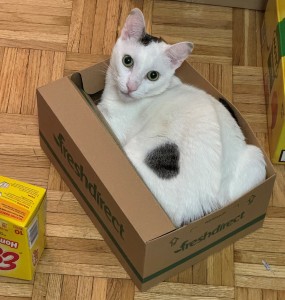If you’ve ever seen a cat ooze under a door or spill into a vase, you’ll understand why some people consider cats liquids. But what do cats consider themselves?
When an animal thinks about its own proportions–how tall it is, or how wide–it’s called “body size awareness”. We humans take this for granted, but even we’re not born with the ability. Children develop it around the same time they start referring to themselves in conversation, suggesting a link to self-awareness.
Scientists know that dogs possess body size awareness. A recent study found that our canine friends will hesitate when confronted with an opening that feels too small for them. Cats do too, according to a new study, but only in certain circumstances.
Researchers in Budapest visited felines in their homes (because cats are notoriously difficult to study in the lab), and placed a large piece of cardboard at the bottom of the stairs. Cats sat on one side and their owners (armed with toys or treats) sat on the other. The scientists then confronted the felines with a series of holes in the cardboard of narrowing height or width.
As the height of the aperture shrunk, the cats began to hesitate, a sign of body awareness. But they didn’t hesitate at all as the width shrunk, even when it became a slot barely half the width of their bodies. “They don’t use body awareness in this case—they’re basically like liquids,” says the study’s author, Péter Pongrácz.
So what does all of this mean for owners? Don’t assume that your cats can’t squeeze through that narrow door opening–or that slightly cracked window. I’m shutting mine now.


